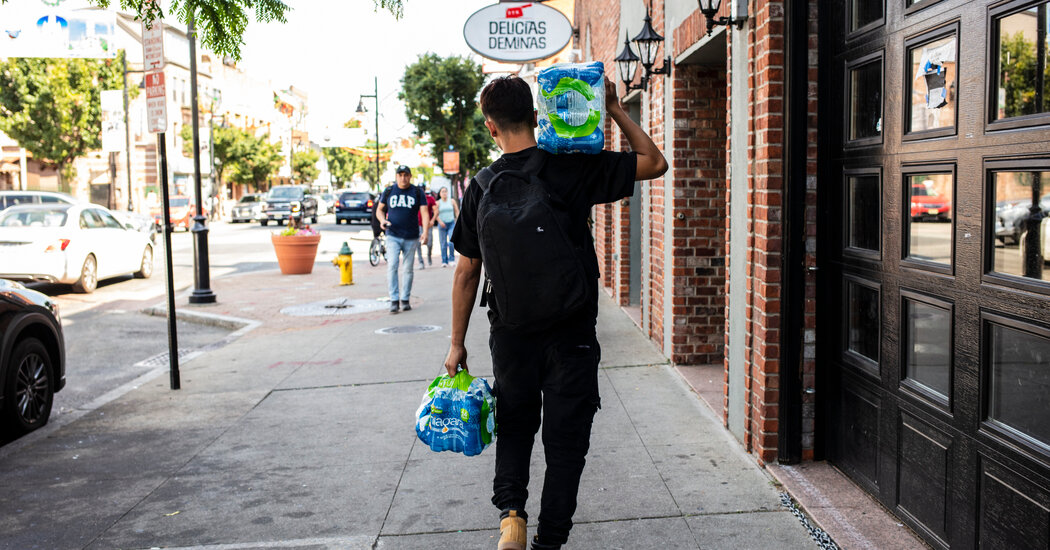
New Jersey is heating up faster than any other state in the Northeast, pacing a region with rapidly rising temperatures, according to data gathered by a nonprofit research organization.
The cause of New Jersey’s dubious distinction is most likely a combination of factors, including the warming of the ocean bordering the coastal state and overdevelopment in some areas, experts say.
But what is certain, they added, is that the state — and the Northeast in general — will continue to see more heat waves like the one last month, as well as worsening storms and floods.
“New Jersey is ground zero for some of the worst impacts of climate change, including extreme heat and considerable increases in flood risk,” said Shawn M. LaTourette, the commissioner of New Jersey’s Department of Environmental Protection.
While average annual temperatures across the country have increased by about 2.5 degrees since 1970, annual temperatures in New Jersey have increased by roughly 3.5 degrees, said Lauren Casey, a meteorologist with Climate Central, the nonprofit organization that gathered the temperature data.
According to the group’s findings, New Jersey is the third fastest warming state in the country.
A spokesman for the Department of Environmental Protection, which published a report in 2020 that also noted the state’s rapidly rising temperatures, said that the state is heating up faster than its neighbors because it is at the southern end of the Northeast region and because of its built-up cities. “Importantly,” he said, “land use patterns and development density in the state make for conditions that set up an urban heat-island effect.”
The heat-island phenomenon describes how cities, with all of their concrete and asphalt, soak up heat, making them several degrees warmer than surrounding areas. Newark, the most populated city in New Jersey, for example, can reach 100 degrees in the summer, while other spots in the state stay in the 90s.
Delaware, New Jersey’s mid-Atlantic neighbor, comes in second in Climate Central’s ranking of the fastest warming states, with a 3.6 degree increase between 1970 and last year. And Alaska, which extends into the Arctic, an area experiencing rapid snow and sea ice loss, comes in first, with an increase of over 4 degrees.
The Northeast has the fastest warming cluster of states in the country, the data from Climate Central shows. In addition to New Jersey, Massachusetts, Rhode Island, Connecticut, Vermont, New Hampshire and Maine all made the top-10 list (New York comes in at No. 11). They all have experienced temperature increases of over 3 degrees, and are warming faster than sizzling spots like Arizona and Texas.
A 2021 study links rapid warming in the region to the heating up of the adjacent Atlantic Ocean, the currents of which have possibly been affected by glacial melt farther north.
David Robinson, the New Jersey state climatologist and a geography professor at Rutgers University, believes that since New Jersey is a long, relatively thin state that hugs the coast, the heat from the ocean has more of an impact there than in other coastal states like New York, which extend much deeper inland.
Rising heat means more relative humidity, which makes the experience of it — known as the heat index — even more uncomfortable.
Warmer air can hold more water vapor, turning the atmosphere into a big sponge, ready to be released in a downpour by the next storm system, said Art DeGaetano, the director of the Northeast Regional Climate Center at Cornell University. This helps explain why the Northeast is seeing more extreme rainfall.
According to the 2020 report, annual rainfall in New Jersey is expected to increase between 4 percent and 11 percent by 2050. Flooding has been particularly pronounced in the state, which is surrounded by water on three sides. Hurricane Ida in 2021, for example, killed 30 people in New Jersey, more than in any other state.
The state’s Department of Environmental Protection released an extreme heat action plan this spring, and it also offers a website, Heat Hub NJ, that explains the dangers of extreme heat and provides strategies for dealing with it.
Meteorologists and climate scientists warn that highlighting states and even regions as warming faster than other places — distinctions that can come down to tenths of degrees — misses the broader point that the planet is heating up everywhere.
But a graph by the National Oceanic and Atmospheric Administration plotting temperatures in New Jersey going back to 1895 looks like a roller coaster with higher and higher peaks. Heat in New Jersey, it clearly shows, is going only in one general direction: up.
While rising temperatures in the Northeast — and New Jersey in particular — are still something of a mystery, Dr. Robinson, who has been tracking the five coldest and hottest months in the state since 1895, had some incontrovertible data to share: Eighty percent of New Jersey’s warmest months have occurred since 1990. And there has not been a top-five coldest month in New Jersey since 1989.
“I’ve been a state climatologist for 33 years and I’ve never seen a statistic like this,” he said.
The post New Jersey Is One of America’s Fastest-Warming States, Data Shows appeared first on New York Times.